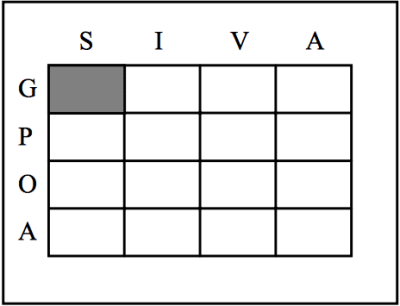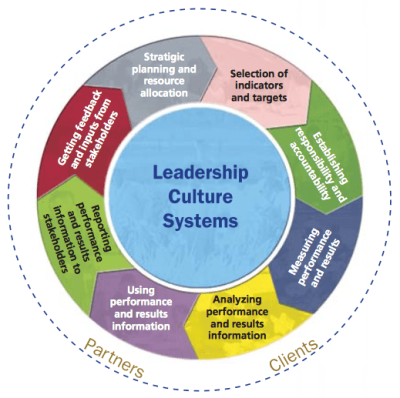Results Based Management and Logical Framework Approach are distinct performance management frameworks widely used in the UN (RBM) and NGO (LogFrame) sectors: both have strong similarities with strategic performance management frameworks used in other kinds of organisation.
Both frameworks seek to tie the provision and management of development funds to relatively formal descriptions of the outcomes being sought through the work being funded. Both also require descriptions of the actions to be carried out (and so funded) and the methods by which progress / results will be measured, to be included and used in the monitoring activity.
The mandatory requirement for organisations using these tools to measure of the progress / results of a funded project has encouraged the development of sophisticated performance measurement methods based on these tools in many NGOs - but the important role of these tools play in obtaining funding for projects has also pushed use of the frameworks towards Monitoring and Evaluation rather than strategic management.
The Logical Framework Approach (LogFrame)
History
Logical Framework Approach (LogFrame) was developed for USAID by a consultancy in the late 1960s, and its use became a requirement for the projects USAID funded from 1970.
Since then the framework has been adopted as a funding pre-requisite by many other fund giving organisations, and unsurprisingly the framework has become a familiar internal project management approach in may (fund receiving) NGO type organisations.

How it works
At its simplest, LogFrame is simply a four-by-four matrix. Filling in the intersections within the matrix encourages project teams to consider wider aspects of a project: in particular to consider how progress or achievement will be recorded.
The first of the two dimensions of the matrix has four headings Goals, Purpose, Outputs, and Activities.
The second dimension lists four descriptive aspects - Summary, Indicators, Verifications and Assumptions.
Over time a rich infrastructure of common processes and activity lists has been developed to help project teams complete LogFrame grids, and in NGOs in particular, LogFrame documentation is a standard pre-requisite for any project.
The Results Based Management Framework (RBM)
History
Results Based Management (RBM) is an evolution of a standardised budgeting system introduced within UN Agencies in the late 1990s.
That system - called Results Based Budgeting - required Agencies to attach information about the outcomes being sought and methods being used to budget requests, but had no formal requirement for how this information was to be communicated. This lead to a multitude of incompatible formats for documenting these ancillary elements, and much confusion.
In the mid-2000s a revised version of RBB was introduced that specified a standard format for this ancillary information, and also a raft of standard management processes to be used alongside these statements. This revision to RBB was called Results Based Management, and it has since become the mandated approach to programme management within UN linked organisations.
How it works
RBM is quite complex due the many roles it fulfils within the UN, but at its core is a four-by-four matrix (called the Design and Monitoring Framework in RBM) similar to that found in LogFrame.
The main difference is that the labelling of the four LogFrame dimensions is slightly changed - with Impact and Outcomes replacing Goals, and Purpose.


RBM also includes a useful eight-step management process that encapsulates a cycle encompassing definition use and revision of the Design and Monitoring Framework.
This management process echoes the design of the various strategic management cycles popular in the commercial sector.
Links to other frameworks
Results Based Management and Logical Framework are examples of Strategy Execution Frameworks and as such fit into a standard progression of performance management tools:
- Measures - simply collecting information on an activity or outcome within an organisation
- Measures and Targets - adding information about what level of activity or outcome is required / expected, and usually a time when the required performance should be delivered by
- KPIs - a small number of Measures and Targets that are communicated widely within an organisation as 'priority' performance goals to be considered
- OKRs - KPIs linked to a clear outcome that is the reason why the KPI has been selected
- Balanced Scorecard - a collection of KPIs / OKRs that are linked thematically or causally to provide a more complete picture of the outcomes required for an organisation
- Strategy Execution framework - advanced Balanced Scorecard style measurement systems linked to a clear longer term view of the future state required for an organisation and a set of management behaviours that focuses upon the communication and monitoring of a programme of strategic change - examples include 3rd Generation Balanced Scorecard and Results Based Management systems.
By providing a management process within which to create, use and maintain a complex performance management report, a strategy execution framework opens the way for an organisation to maximum benefit from its performance management activities. When combined with best practice design methods such as ACME or ERIC, which allow for time and resource efficient design of performance management approaches for single or multiple units within an organisation, they represent modern best practice.
To dig deeper
There are wikipedia entries for Results Based Management, and for Logical Framework, and a useful research paper written by 2GC on links between these frameworks and modern Balanced Scorecard. All three resources have reading-lists / citations attached that can form a good basis for starting further investigations of the topic.
